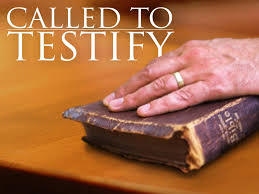 In today’s gospel, St. John tells us the importance of witness, or as he writes: ““When the Advocate comes whom I will send you from the Father, the Spirit of truth who proceeds from the Father, he will testify to me. And you also testify, because you have been with me from the beginning.” (John 15:26-27). The entirety of the the Gospel of John is structured around testifying, around giving witness.The first main section of the Gospel of John, from 1:19 to the end of Chapter 12 is called the “Book of Signs.” It includes the seven signs of the reign of God as evidence, as witness, to a new creation. The seven signs are
In today’s gospel, St. John tells us the importance of witness, or as he writes: ““When the Advocate comes whom I will send you from the Father, the Spirit of truth who proceeds from the Father, he will testify to me. And you also testify, because you have been with me from the beginning.” (John 15:26-27). The entirety of the the Gospel of John is structured around testifying, around giving witness.The first main section of the Gospel of John, from 1:19 to the end of Chapter 12 is called the “Book of Signs.” It includes the seven signs of the reign of God as evidence, as witness, to a new creation. The seven signs are
- Changing water into wine at Cana in John 2:1-11
- Healing the royal official’s son in Capernaum in John 4:46-54
- Healing the paralytic at Bethesda in John 5:1-15
- Feeding the 5000 in John 6:5-14
- Jesus walking on water in John 6:16-24
- Healing the man blind from birth in John 9:1-7
- The raising of Lazarus in John 11:1-45
The seven signs are seen by some scholars and theologians as evidence of new creation theology in the Gospel of John. From the beginning of the Fourth Gospel there has been a theme of newness and of creation. The Prologue refers to the power and role of the Word of God in the story of Creation. Then, very subtly, it continues to recount a new creation in the Incarnation of Jesus. In John 1:29 you see the phrase, “the next day” as John the Baptist testified to Jesus. “The next day” the first apostles are called in v.34 and following. The “next day” (v.43), now day four of the new creation week, Philip and Nathanael are added as disciples. “On the third day…” (Jn 2:1) we come to the Wedding at Cana (John 2:1-11). According to the Johannine imagery, we are on the seventh day of the new creation week. The creation week reaches its climax – the unveiling of the public life of the Anointed One of God.
This is not the only reference to “seven” in the Fourth Gospel. There are seven who bear witness to Jesus – “witness” being a central theme of today’s gospel. Who are the witnesses? Each of the three Persons of the Trinity does this—the Father (5:31–32, 34, 37; 8:18), Christ himself (8:14, 18; cf. 3:11, 32; 8:37), and the Spirit (15:26; cf. 16:14). The works of Jesus bear witness (5:36; 10:25; cf. 14:11; 15:24), as does sacred Scripture (5:39; cf. 5:45–46). A sixth witness is John the Baptist, while seventh is the variety of human witness consequent on the ministry of Jesus, that of the disciples (15:27; cf. 19:35; 21:24), the Samaritan woman (4:39), and the multitude (12:17). This emphasis on testimony should not be minimized. Testimony is a serious matter and the means of substantiating the truth of a matter; there is a legal air about it. It is clear that our author wants his readers to take what he writes as reliable. He is insistent that there is good evidence for the things he sets down. Witness establishes the truth. This bearing of witness was not an end in itself. Behind it was the purpose “so that all might believe through him.”
In the religious context we hold the word “witness” to be the telling of an encounter of the work of God in one’s life – as in to give witness, to testify, to give testimony. All of which is also language from courtroom. In today’s gospel the setting definitely has the feel of a court setting with prosecutor and defense attorney. Perhaps that it just the harbinger of what is to come during Holy Week, when Jesus find himself before the Sanhedrin and then before Pilate, truly on trial. There Jesus will be silent, giving no testimony. His public life has already established the truth. He indeed is “guilty” of the charges that He proposed to the world that He was the true King of this new creation and claimed to be God.
